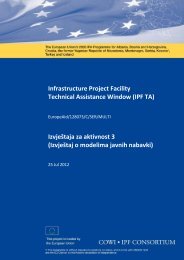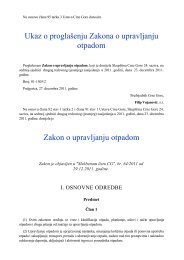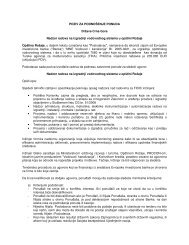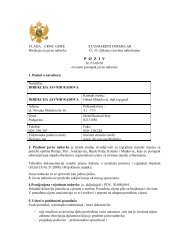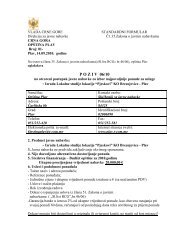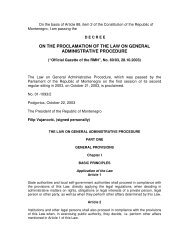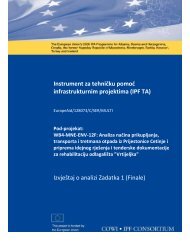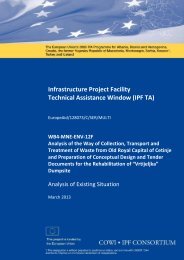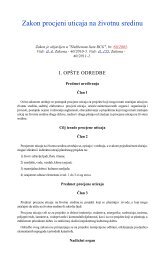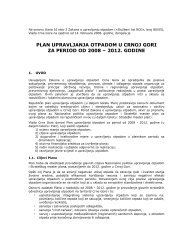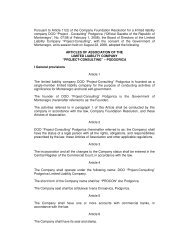Infrastructure Projects Facility Technical Assistance Window (IPF TA ...
Infrastructure Projects Facility Technical Assistance Window (IPF TA ...
Infrastructure Projects Facility Technical Assistance Window (IPF TA ...
Create successful ePaper yourself
Turn your PDF publications into a flip-book with our unique Google optimized e-Paper software.
<strong>Infrastructure</strong> <strong>Projects</strong> <strong>Facility</strong> – <strong>Technical</strong> <strong>Assistance</strong> <strong>Window</strong><br />
Sub project: WB4-MNE-ENV-12B: Management Models and Options for Cost Recovery for the Future Construction and<br />
Operation of Regional Landfills in Montenegro<br />
27<br />
4.4.4 Law on Environmental Impact Assessment<br />
The Law on Environmental Impact Assessment6 regulates the process of environmental<br />
impact assessment for projects that can have a significant impact on<br />
the environment, the contents of the study on impact assessments, the participation<br />
of interested institutions, organizations and the public, the process of assessment<br />
and issuing of approvals, information on projects that can have a significant<br />
impaction the environment of another state, control and other issues of<br />
importance to assess the impaction the environment. Regional landfills in Montenegro<br />
require an environmental impact assessment.<br />
Several bylaws were passed prior to the date on which the Law came into effect<br />
(1 January 2008), including the Decree on projects subject to EIA7; Rulebook<br />
on content of documentation to be submitted together with request for determination<br />
on the need for EIA8; Rulebook on content of documentation to be submitted<br />
together with request for determining the EIA scope and contents of the<br />
EIA study9; Rulebook on content, form and a way of keeping the public record<br />
on actions and decisions on EIA10; and Rulebook on contents of the EIA<br />
study11. The EIA law and related secondary legislation are harmonized with<br />
the EU Directive 85/337/EEC on the assessment of the effects of certain public<br />
and private projects on the environment, as amended by 97/11/EEC and<br />
2003/35/EC. The requirements of EU Directive 2003/4/EC and Directive<br />
2003/35/EC on public access to environmental information, public participation<br />
in decision-making and access to justice, were transposed into this Law.<br />
In terms of projects that are subject to EIA, the Decree on projects subject to<br />
EIA divides activities into two lists; for projects on the first list, the EIA is<br />
mandatory, while for projects on the second list, an EIA may be required.<br />
Essentially any major investment in the solid waste sector requires an EIA. The<br />
types of solid waste projects that fall under List 1 are contained in the annex to<br />
the law, under point 11 (“other projects“) and include:<br />
• Installations for the treatment of hazardous waste by incineration, chemical<br />
or biological treatments as well as landfills for temporary and permanent<br />
storage of hazardous and radioactive waste.<br />
• Waste disposal installations for the incineration or chemical and biological<br />
treatments, temporary storage and permanent disposal of non-hazardous<br />
waste, including municipal and inert waste, with a capacity exceeding 100<br />
tonnes per day.<br />
6 Official Gazette of GoM, No. 80/05<br />
7 Official Gazette of Montenegro No 20/07<br />
8 Ibid.<br />
9 Ibid.<br />
10 Ibid.<br />
11 Ibid.<br />
.



